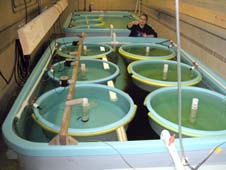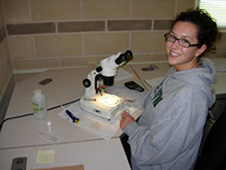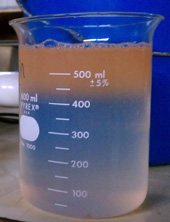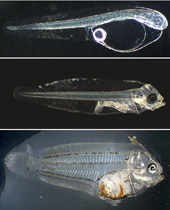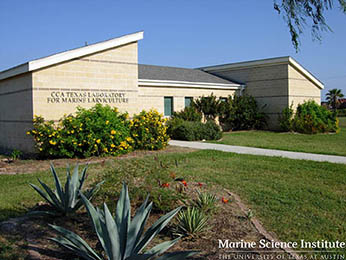
The CCA Texas Laboratory for Marine Larviculture is a specially designed facility for research on rearing larval fishes, one of the most significant bottlenecks in marine fish culture. Highly replicated experiments are the key to strong research and this 3,000 square foot building contains two seawater labs, each with three tanks that each hold 1,500 gallons. Each of these tanks can be divided into as many as 6 replicate tanks, making it possible to run experiments in 36 tanks at once. An important feature of the building is the extremely fine control of water temperature and salinity that can be maintained during experiments that last weeks or even months, making research possible year round regardless of the extremes of the outside conditions. The two labs are connected by a live food preparation area where algae, rotifers, and brine shrimp are cultured continuously to feed the delicate and finicky larval stages of a variety of species of fishes. Another connector provides office and laboratory space for researchers.
In January 2006, the University of Texas Marine Science Institute proudly announced a generous gift of funds from the Coastal Conservation Association - Texas to create a state-of-the-art facility for research into the early life stages of marine fishes. The staff of the Fisheries and Mariculture Laboratory immediately got to work on the design of their ideal laboratory, and the grand opening took place in August 2007. Since that time, the CCA Texas Laboratory for Marine Larviculture has been the site of several significant research efforts.
We are devoting a lot of research activity to southern flounder. We have defined the optimal temperature for rearing larvae from Texas. We also discovered how rearing temperatures alter the proportion of males to females. Results from both of these studies were markedly different from findings of colleagues working on southern flounder from North Carolina, highlighting the importance of geographic differences in this species. We have conducted trials to accelerate weaning -- switching from live food to a dry diet -- in southern flounder. We are examining the influence of yolk composition and larval diets on the ability of larval southern flounder to escape from predators after stocking, and how the larval diet might solve the problem of malpigmentation that develops in juvenile flounder, which makes them more susceptible to predators and less appealing to customers in the fish market.
We are also using this lab for work with several other species. We are developing rearing technologies for pigfish (Orthopristis chrysoptera) with the aim of successful commercial production of this popular baitfish. We investigated the feasibility of rearing all early life stages of red drum, from hatching through the early juvenile stage, entirely in recirculating systems using different stocking densities and weaning strategies. We studied digestive enzymes in juvenile cobia (also known as ling) and found that these fish are able to digest the chitin that makes up the shell of shrimp, suggesting that shrimp processing waste from could replace fish meal in cobia feeds to make the process more sustainable. We have also initiated studies of optimal lighting for larval survival and growth in red drum.




